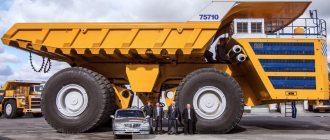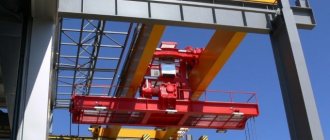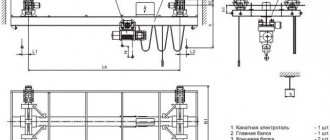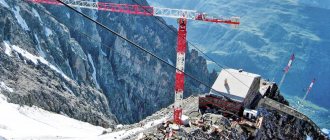During the construction of various types of structures and in many industrial sectors, there is a need to use lifting and transport mechanisms. We often have to deal with cargo that weighs more than a thousand tons. The largest crane in the world is capable of lifting loads weighing 20 thousand tons.
Crane equipment differs in design features, methods of movement, type of support and other parameters, which directly affects the load capacity. The leading positions in the ranking of the most powerful lifting machines are occupied by representatives of China, Japan, and South Korea.
Kroll K-10000
Self-propelled rail-mounted tower crane, manufactured in Denmark. Among machines of this type, it is a real giant, especially in terms of carrying capacity. K-10000 is intended for the construction of large industrial facilities and power plants.
One of these cranes was used in Russia during the construction of power units at the Rostov NPP. Similar mechanisms are also used in a stationary position, being installed in the foundation. The design provides for the presence of an auxiliary crane, with the help of which the main one is installed.
Specifications:
- load capacity - 360 tons;
- main boom radius - 82 m;
- the height of the structure is 143 m.
Types of arrows
Tower crane booms can be classified according to the method of departure:
The following classification of arrows is based on a design feature:
- hanging;
- suspended with balancer;
- hanging with a jib;
- hanging with stands;
- hammer-shaped
According to the type of arrow section there are:
- square;
- rectangular;
- triangular.
Tower crane booms can be installed in several ways.
The most cost-effective and fastest assembly method is to attach the boom and winch to the tower in a lying position on the ground.
The structure is lifted using its own winches. The second way is to build a constructor. That is, the crane elements are assembled one at a time in a vertical position at once, and the boom is raised last before connecting the electric current.
Zoomlion ZACB01
A wheeled crane from a Chinese company, included in the Guinness Book of Records. The basis of the mechanism is a 12-wheel chassis, the length of which exceeds 21 meters. To ensure stability, there are 4 ball bearings that extend during preparation for the work process.
The crane operator's cabin rotates 360 degrees. The ZACB01 is equipped with an 8-section telescopic boom, with each section capable of extending up to 13 meters. The release of the self-propelled vehicle was timed to coincide with the 20th anniversary of the Zoomlion company. The cost of the truck crane is almost one and a half million dollars.
Peculiarities:
- load capacity indicators - 2,000 tons;
- lifting height - 106 m;
- crane height when folded is 4 m.
The largest truck crane: clash of the titans
Truck cranes differ from tower cranes in their greater mobility: they do not need to be assembled and disassembled, they will get to their destination on their own, and at the same time they will be able to transport cargo.
Speaking of cargo. The lifting capacity of many truck cranes often exceeds 1 thousand tons and, most likely, in the future this figure will not become the limit.
One of the recognized leaders among automotive cranes is the wheeled Liebherr LTM-11200-9.1, the main task of which is the installation and installation of wind power generators.
This unit, originally from Germany and unofficially called “Mammoth,” has the longest telescopic boom in the world and the largest lifting capacity: 100 meters and 1200 tons, respectively.
In order for such a colossus to stand and move stably, it is equipped with no less than nine axes. While moving, the crane can reach speeds of up to 70 km/h.
The maximum height to which the Liebherr LTM-11200-9.1 can lift a load is 188 meters. This is approximately the height of a 50-story building, twice the height of the famous Niagara Falls!
Among the main competitors of the German “Mammoth” is the ZACB01 truck crane from the largest Chinese company Zoomlion.
The manufacturing company made the release of this model a gift for its own 20th anniversary, which happened in 2015. The gift was a success: ZoomlionZACB01 entered the Guinness Book of Records due to its outstanding load capacity (2000 tons), displacing Liebherr LTM-11200-9.1 from the first line.
True, the Chinese giant is significantly inferior to the German in stability. This truck crane prefers ideal surfaces, which are rare on construction sites. The cost is also significant: the price of the ZoomlionZACB01 significantly exceeds a million dollars, and most often they prefer not to buy the most powerful of the currently existing truck cranes, but to rent them.
Photo: liebherr.com
Liebherr LR13000
A crawler crane from a German manufacturer, the design of which has a large margin of safety. The machine is able to operate without a balancing weight thanks to the powerful ring rotating structure. If there is a need for a counterweight when lifting to a greater height, 25-ton blocks are installed.
The machine is economical in terms of transportation, since its individual components weigh no more than 70 tons. High levels of fault tolerance are ensured by the presence of redundant drives. LR13000 is used, in particular, in the construction of drilling platforms, bridges, and nuclear power facilities.
Specifications:
- load capacity 3,000 t;
- lifting height - 236 m;
- maximum boom reach is 200 m.
How lifting equipment works
The tower crane is equipped with a vertical slewing tower on which the boom is attached. This special equipment is controlled from the driver’s cab. It is usually located at the top of the tower at a considerable height from the surface. The design of the tower crane allows it to perform the following operations:
Tower crane structure
- lifting and lowering loads;
- changing the boom radius by moving the hook relative to the main axis;
- rotation at a certain angle;
- moving the machine.
Lifting of loads is carried out thanks to the presence of a cargo winch, rope and hook suspension. The rotation of the rotating part occurs relatively stationary due to the presence of a special rotation mechanism. These two parts are connected to each other by a rotary support device. It is this that transfers the tipping forces from the turning part to the running frame.
Terex CC8800-1 TWIN
Crawler self-propelled jib crane made in Germany. The demonstration of the model, which has four modifications, was carried out in 2007. The machine is equipped with a double lattice boom, which significantly increases the load capacity.
Thanks to their modular design, such large cranes can be easily transported anywhere in the world. In addition, Twin is able to move while fully loaded, which saves a lot of time. The model is ideal for working with large cargo.
Peculiarities:
- load capacity - 3200 t;
- total height of the main boom and jib - 235 m;
- The length of the track base in working position is 14 m.
How to draw a crane
A crane has a difficult life: either lift the bricks, or lower the pipes, or stand straight and don’t fall. But if you are drawing a construction site, you cannot do without a drawn crane.
Our crane will be one of those that ride on special rails. Let's draw the wheels and, accordingly, the rails.
The “body” of the crane looks like the Eiffel Tower, it’s more fun.
Let's strengthen the crane with such zigzags.
Let's draw a horizontal arrow. Don't stand under the arrow, yeah.
In the “armpit” of the crane we will draw a cabin.
To prevent the crane from tipping over when lifting something heavy, a counterweight is required. Let's draw some heavy slabs behind...
...and to be sure, we’ll wrap it tighter.
Cable with hook...
...and in the cab there is a smiling driver.
Let's draw a more interesting load!
I also recommend:
risuem-sami.ru
ALE AL.SK190
A British model that takes pride of place in the list of powerful cranes in terms of lifting capacity. Two lifting units were put into operation in 2008 and 2011. ALE AL.SK190 was specially built for a petrochemical contract in Saudi Arabia.
The crane is equipped with a double lattice boom and is mounted on a platform ring. To lift loads, the use of cable jacks is provided, the lifting capacity of which is about 600 tons. Now machines of this type operate in the USA and Thailand, and 130 containers were needed to transport them.
Specifications:
- copes with loads weighing up to 4,300 tons;
- range of action - 84 m;
- maximum boom reach is 200 m.
The structure of a tower crane and the principle of its operation
Each mechanism consists of a similar set of elements. The tower crane structure includes:
- supporting part (base);
- rotating device;
- a horizontal guide (boom) along which the lifting winch moves;
- vertical stand (tower);
- cabin with controls;
- chassis (mechanism for moving the entire unit).
The operating principle of a tower crane is based on lifting an object of permitted mass using a cargo winch. This design provides the necessary total moment of the weight of the boom and the counterweight with the weight of the fixed object. The counterweight can consist of several stacked elements, for example, reinforced concrete structures. As a result, the sum of the so-called stabilizing moments must always exceed the sum of the overturning moments. Based on this position, the required boom reach is calculated. Ensuring the maximum coverage area necessary to move the cargo is achieved by extending the boom, turning it horizontally, moving the cargo winch and moving the unit itself.
DLV4000
Chinese lifting and transport mechanism for work afloat. The structure is serviced by 250 people, while the crane can operate on the open sea for 2 months without replenishment. The DLV4000 works primarily where gas and oil fields are being developed.
The effectiveness of using a technological innovation is explained by its cost-effectiveness, the ability to reduce time costs and reduce the number of cycles of lowering and lifting loads. The crane helps to carry out work in hard-to-reach places and at significant sub-zero temperatures.
Peculiarities:
- lifts loads weighing up to 4,400 tons;
- 174 meters long;
- speed - 12 knots.
Sarens SGC-250
The presentation of the super crane from Sarens, a world leader in the field of lifting and moving heavy loads, was held in 2022. This is the most powerful machine in terms of size and carrying capacity of all those created by the Belgian manufacturer.
The SGC-250 is capable of moving in working condition from one position to another, which is achieved through two sets of wheels: one is designed for full rotation, the other is used for movement. The production of the crane on wheels was carried out in compliance with European and world standards.
Specifications:
- lifts loads weighing up to 5 thousand tons;
- lifting height - 250 m;
- the length of the main boom is 160 m, the length of the jib is 100 m.
Largest crawler crane: Germany vs China
Crawler cranes are the real heavy lifters of the lifting world. They are capable of lifting loads of over 3,000 tons, which are too much for either tower or car models.
The market for this type of cranes is widely developing in China.
In 2011, Sany released a crawler crane that lifted 3.2 thousand tons, which became a record, but the triumph did not last long. In 2013, the XGC88000 crane from the Chinese manufacturer XCMG was born, and this model was able to lift 3.6 thousand tons.
Photo: xcmg.com
Biggle 125D AFRD
A heavy-duty crawler super crane that has a modular design and is capable of servicing several objects simultaneously. It is equipped with a closed cabin and can operate using diesel-hydraulic or diesel-electric power systems.
The lifting capacity of a construction crane depends on the length of the boom. The lower its performance, the more weight the machine can lift. One of the advantages is maintaining stability in wind gusts of up to 240 km/h. The 125D AFRD is easily mounted and transported to its destination on special platforms.
Peculiarities:
- load capacity - 6,803 tons;
- lifting height - 91 m;
- maximum boom length is 170 m.
Svanen
A self-propelled single-lift floating crane, the name of which is translated from Swedish as “swan”. The owner of the project is the Dutch company Ballast Nedam. Initially, construction was carried out at a shipyard in Spain, with final work carried out in the Netherlands.
Svanen was built for the construction of large bridges, but is now used to assemble offshore power plants. At first, the crane could withstand loads weighing up to 6,500 tons, but after several upgrades its lifting capacity increased significantly.
Specifications:
- lifts loads weighing up to 8,700 tons;
- lifting height - 76 m;
- length - 102.75 m.
Hyundai 10000
In 2022, a real giant appeared at the Hyundai Heavy Indusries shipyard in South Korea - the Hyundai 10000 floating crane. The machine is equipped with four booms: two of them are retractable, two serve as a counterweight. When lifting particularly heavy loads, special tanks are filled with sea water.
Energy for the crane is supplied from 4 main generators and 2 additional ones. To be on the safe side, an emergency backup device is installed. The Hyundai 10000 was able to prove its performance by performing work to move the Norwegian company's drilling platforms.
Peculiarities:
- load capacity - 10 thousand tons;
- 180 meter main booms;
- 70 meter counterweights.
Basic structural elements
Thanks to the well-thought-out design of the tower crane, its efficient and safe operation is ensured. The main structural elements of this special equipment are called:
Tower crane diagram
- frame. It can be self-propelled or moved using a wheeled or tracked tractor on which other elements are attached;
- slewing support mechanism. Located at the bottom or top of the tower;
- support platform;
- counterweight. Prevents the machine from tipping over when moving heavy loads;
- tower. The main element that gives special equipment the necessary height and absorbs most of the load;
- cabin. Placed at a considerable height for a better overview of the operations being performed;
- arrow. Provides horizontal movement of cargo using special load-handling mechanisms;
- running trolley. Contains the chassis of the frame;
- console. Plays an important role in ensuring the balance of a specialized machine and prevents it from tipping over;
- head. Used to change the position of the boom in the vertical direction;
- cargo trolley. Present on the beam boom and used to move the load.
Dimensions of the Liebherr-132EC-H8 tower crane
SSCV Thialf
The most powerful floating lift in the world. Year of commissioning - 1985. The design from the Japanese manufacturer consists of two pontoons standing on four vertical columns, which, in turn, can change the depth of immersion.
Each pontoon is equipped with cranes, each with a lifting capacity of 7,100 tons. In 2016, the lower deck was completely modernized using certified materials. The port to which Thialf is currently assigned is in Panama.
Technical specifications:
- total carrying capacity - 14,200 tons;
- structure height - 96 m;
- winch lowering depth - 307 m;
- the total length of the crane is 202 m.
Draw a crane
Lifting cranes can be either mobile, the base of which is a KAMAZ, or stationary, which are mounted and dismantled directly at the construction site. You can draw a crane as follows:
In this section I will show you how to draw a crane step by step
. You can draw it by hand while looking at your computer monitor; or you can print this page out on a piece of paper to see each step closer.
Follow the red lines in each illustration to find out exactly what to draw in this step. The lines drawn in the previous steps are highlighted in grey. I'll show you an illustration of each step and then give you a detailed description of how to draw it. 1.Draw the base.
Draw the base of the car - an oblong shape with rounded cutouts where the wheels will be located.
2. Draw the wheels.
Draw four ovals inside the cutouts for the wheels. Inside each oval, draw two more ovals, one inside the other, in the form of rings.
3. Draw the tires.
Make the tires look real by adding width to the outside of the wheels. Add depth to the inside of the wheels.
4. Add depth to the base.
To construct the body of the crane, draw the lines shown in the figure. Remember to make the lines curved or straight where shown in the picture.
5. Draw the windshield and bumper.
Draw a rectangular shape for the windshield and two shapes for the side windows. Then draw two squares for the headlights on the front of the cabin. Draw the front bumper as a long, rounded rectangle.
Use a ruler to draw diagonal lines on the bumper. Near the back of the truck, draw a triangle with a rounded top. Draw a second line to add depth.
6. Draw a faucet.
Draw a faucet that consists of three rectangular shapes. Each rectangle is slightly shorter and smaller than the previous one. Use a ruler to get straight lines.
Round the edges of the last rectangle. Draw lines that add depth.
7. Draw the crane hook.
Add four lines at the end of the rounded rectangle. Draw an inverted triangle at the bottom of the lines. Add a second line along one side of the triangle. Draw a hook below the triangle.
8. Draw the hydraulics of the crane.
Draw two hydraulic cylinders that raise and lower the crane. Draw a circle that connects the front cylinder to the faucet, adding a circular line to show depth.
Draw back triangular supports. Add a safety light on the roof of the driver's cab.
9. Draw the crane supports.
Draw special supports for the crane that should protect it from falling when it lifts heavy objects. The supports are rectangular in shape, with pyramids at the ends, near the surface of the earth.
For example, like this:
So, let's draw a crane. I taught my little son how to draw a crane using the photo diagram below, which shows all the drawing steps step by step. If you follow these step-by-step instructions, you will definitely succeed. I wish you good luck in your creativity!
risovat-legko.com
Taisun
A stationary giant created by a Chinese company. It took 10 years to design and put into operation the mechanism. Now "Teysun" is fully operational in Shandong province. It is used for the construction of oil platforms and the construction of tankers.
Peculiarities:
- weight of the lifted load - 20,000 tons;
- lifting height - 80 m;
- crane height - 133 m.
To install reinforced concrete supports, a pit was dug, after which it was filled with concrete. "Teysun" has been operating since April 2009. During the festive ceremony, he received an award for lifting a barge weighing just over 20 thousand tons to a 30-meter height.











